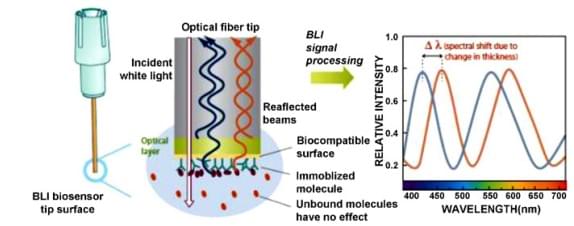Bio-layer Interferometry (BLI)
Creative Biostructure has rich experiences to perform MagHelix™ BLI technique. We can help customers to accelerate research progress in a highly productive and cost-effective way. BLI is a biosensor technique that can be used to measure biomolecular interactions between protein-protein, protein-liposome, etc. It can be applied to a wide pharmaceutical field of protein quantitation, affinity and kinetics determination, drug/antibody screening, library screening, drug/antibody discovery, and optimization of drug process development.
 Figure: The diagram of the BLI.
Figure: The diagram of the BLI.
It is well known that surface plasmon resonance (SPR) is an important tool to study protein-protein interactions in vitro, such as kinetics of binding and dissociation. Recently, the new technique bio-layer interferometry has become an alternative method to SPR. Compared with SPR, BLI has its advantages and disadvantages. The main advantages of BLI mainly include: a) the sensors number of BLI can be scaled up more easily and the biocompatible matrix coated is more commercially available; b) it offers a unique high throughput platform; c) the association phase is not fixed long time but only restricted by evaporation of the sample; d) there is no risk for clogging; e) the analyzed samples can be recovered and then used in other applications; f) it requires only a little nanomole amounts of sample so it is a good choice to analyze molecules that are difficult to isolate. Besides these characteristics, our MagHelix™ BLI technology measuring biomolecular interactions in real time has general enormous advantages such as label-free, easy to operate and maintain, precise and accurate, applicable to comprehensive samples (including crude ones), non-microfluidic-system, etc. As shown in the figure, it is a single biosensor-tip with two surfaces, a layer of immobilized molecules and an internal reference layer, from which the white light reflects and the interference pattern was analyzed by the analytical technique. When the molecule or the number of molecules in the medium bound to the tip changes, there is a shift in the interference pattern and the wavelength shift (Δ) can be measured in real-time, which means that a change in optical mass results in the same shift in the interferometry wave pattern. And the interference pattern will not be affected when there are no bound molecules and changes in the refractive index. As an efficient tool, BLI has been used to characterize molecular interactions and screen drug targets.
Our MagHelix™ analytical methods for biophysical characterization of biomolecules include but are not limited to:
- Protein Thermal Shift Assay
- Surface Plasmon Resonance
- Isothermal Titration Calorimetry
- Differential Scanning Calorimetry
- Saturation-Transfer Difference
- Bio-Layer Interferometry (BLI) Technology
JakobWallner et al. Application of Bio-Layer Interferometry for the analysis of protein/liposome interactions. Journal of Pharmaceutical and Biomed Analysis. 2013 Jan; 72: 150-4.
Sultana A and Lee JE. Measuring protein-protein and protein-nucleic Acid interactions by biolayer interferometry. Curr Protoc Protein Sci. 2015 Feb 2;79:19.25.1-26.
Ordering Process

